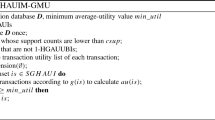Abstract
Mining high-utility itemsets (HUIs) in transactional databases has become a very popular research topic in recent years. A popular variation of the problem of HUI mining is to discover high average-utility itemsets (HAUIs), where an alternative measure called the average-utility is used to evaluate the utility of itemsets by considering their lengths. Albeit, HAUI mining has been studied extensively, current algorithms often consume a large amount of memory and have long execution times, due to the large search space and the usage of loose upper bounds to estimate the average-utilities of itemsets. In this paper, we present a more efficient algorithm for HAUI mining, which includes three pruning strategies to provide a tighter upper bound on the average-utilities of itemsets, and thus reduce the search space more effectively to decrease the runtime. The first pruning strategy utilizes relationships between item pairs to reduce the search space for itemsets containing three or more items. The second pruning strategy provides a tighter upper bound on the average-utilities of itemsets to prune unpromising candidates early. The third strategy reduces the time for constructing the average-utility-list structures for itemsets, which is used to calculate their upper bounds. Substantial experiments conducted on both real-life and synthetic datasets show that the proposed algorithm with three pruning strategies can efficiently and effectively reduce the search space for mining HAUIs, when compared to the state-of-the-art algorithms, in terms of runtime, number of candidates, memory usage, performance of the pruning strategies and scalability.









Similar content being viewed by others
References
Agrawal R, Srikant R (1994) Fast algorithms for mining association rules. In: International conference on very large data bases, pp 487–499
Agrawal R, Srikant R (1994) Quest synthetic data generator. http://www.Almaden.ibm.com/cs/quest/syndata.html
Ahmed CF, Tanbeer SK, Jeong BS, Lee YK (2009) Efficient tree structures for high utility pattern mining in incremental databases. IEEE Trans Knowl Data Eng 21(12):1708–1721
Eltabakh MY, Ouzzani M, Khalil MA, Aref WG, Elmagarmid AK (2008) Incremental mining for frequent patterns in evolving time series datatabases. Computer Science Technical Reports 1707
Erwin A, Gopalan RP, Achuthan NR (2008) Efficient mining of high utility itemsets from large datasets. In: The Pacific-Asia conference on advances in knowledge discovery and data mining, pp 554–561
Chen MS, Park JS, Yu PS (1998) Efficient data mining for path traversal patterns. IEEE Trans Knowl Data Eng 10(2):209–221
Fournier-Viger P, Wu CW, Zida S, Tseng VS (2014) FHM: faster high-utility itemset mining using estimated utility co-occurrence pruning. In: International symposium on methodologies for intelligent systems, pp 83–92
Fournier-Viger P, Lin JCW, Gomariz A, Gueniche T, Soltani A, Deng Z, Lam HT (2016) The SPMF open-source data mining library version 2. Lect Notes Comput Sci 9853:36–40
Grahne G, Zhu J (2003) Efficiently using prefix-trees in mining frequent itemsets. In: IEEE ICDM workshop on frequent itemset mining
Han J, Pei J, Yin Y, Mao R (2004) Mining frequent patterns without candidate generation: a frequent-pattern tree approach. Data Min Knowl Disc 8:53–87
Hong TP, Lee CH, Wang SL (2011) Effective utility mining with the measure of average utility. Expert Syst Appl 38(7):8259–8265
Lan GC, Hong TP, Tseng VS (2012) Efficiently mining high average-utility itemsets with an improved upper-bound. Int J Inf Technol Decis Mak 11(5):1009–1030
Li YC, Yeh JS, Chang CC (2008) Isolated items discarding strategy for discovering high utility itemsets. Data Knowl Eng 64(1):198–217
Liu Y, Liao W, Choudhary A (2005) A two-phase algorithm for fast discovery of high utility itemsets. In: The Pacific Asia knowledge discovery and data mining, pp 689–695
Lin CW, Hong TP, Lu WH (2010) Efficiently mining high average utility itemsets with a tree structure. In: The Asian conference on intelligent information and database systems, pp 131–139
Lin MY, Tu TF, Hsueh SC (2012) High utility pattern mining using the maximal itemset property and lexicographic tree structures. Inf Sci 215:1–14
Lin YF, Wu CW, Huang CF, Tseng VS (2015) Discovering utility-based episode rules in complex event sequences. Expert Syst Appl 42(12):5303–5314
Lin JCW, Li T, Fournier-Viger P, Hong TP, Zhan J, Voznak M (2016) An efficient algorithm to mine high average-utility itemsets. Adv Eng Inform 30(2):233–243
Liu Y, Liao WK, Choudhary A (2005) A fast high utility itemsets mining algorithm. In: The international workshop on utility-based data mining, pp 90–99
Liu M, Qu J (2012) Mining high utility itemsets without candidate generation. In: ACM international conference on information and knowledge management, pp 55–64
Liu J, Wang K, Fung BCM (2016) Mining high utility patterns in one phase without generating candidates. IEEE Trans Knowl Data Eng 25(5):1245–1257
Lu T, Vo B, Nguyen HT, Hong TP (2014) A new method for mining high average utility itemsets. Lect Notes Comput Sci:33–42
Lucchese C, Orlando S, Perego R (2006) Fast and memory efficient mining of frequent closed itemsets. IEEE Trans Knowl Data Eng 18(1):21–36
Pei J, Han J, Mao R (2000) CLOSET: an efficient algorithm for mining frequent closed itemsets. In: ACM SIGMOD workshop on research issues in data mining and knowledge discovery, pp 21– 30
Tanbeer SK, Ahmed CF, Jeong BS, Lee YK (2008) Efficient frequent pattern mining over data streams. In: ACM conference on information and knowledge management, pp 1447– 1448
Yao H, Hamilton HJ, Butz CJ (2004) A foundational approach to mining itemset utilities from databases. In: SIAM international conference on data mining, pp 482–486
Yao H, Hamilton HJ, Geng L (2006) A unified framework for utility based measures for mining itemsets. In: The international workshop on utility-based data mining, pp 27–28
Yen SJ, Lee YS (2007) Mining high utility quantitative association rules. International Conference on Big Data Analytics and Knowledge Discovery, pp 283–292
Acknowledgment
This research was partially supported by the National Natural Science Foundation of China (NSFC) under grant No.61503092 and by the CCF-Tencent IAGR20160115.
Author information
Authors and Affiliations
Corresponding author
Rights and permissions
About this article
Cite this article
Lin, J.CW., Ren, S., Fournier-Viger, P. et al. A fast algorithm for mining high average-utility itemsets. Appl Intell 47, 331–346 (2017). https://doi.org/10.1007/s10489-017-0896-1
Published:
Issue Date:
DOI: https://doi.org/10.1007/s10489-017-0896-1




